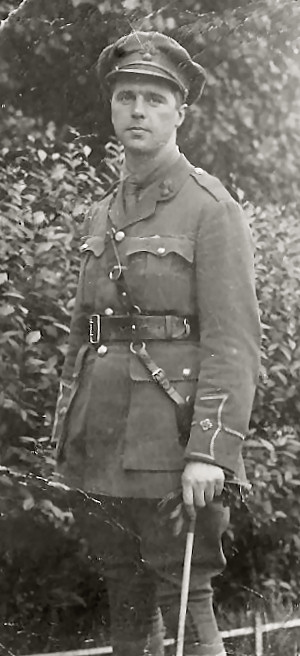Second Lieutenant William Paddock
Serving Soldiers' Biographies
Second Lieutenant William Francis Paddock 4th Battelion, Royal Fusiliers
 William Peters Paddock came to Eaton Bray as Schoolmaster in 1897 bringing with him his wife Katherine Louisa Paddock nee List and the oldest of what was to be four children.
William Peters Paddock came to Eaton Bray as Schoolmaster in 1897 bringing with him his wife Katherine Louisa Paddock nee List and the oldest of what was to be four children.
William Francis Paddock was born in the schoolhouse in Wing Buckinghamshire on the 8th September 1894 attending first Eaton Bray School and then Dunstable Grammar School. The family were to lose both girls at an early age as first their daughter Sophie died in 1899 age 11 months and second daughter Bertha in 1916 age 11 years. Both were buried in Bower Lane. Second son Wilfred went on to marry Stella Minter in 1927.
Below is an account of the life of William Francis Paddock from The British Roll Of Honour.
Biography

9th April 1917 was the start of the Battle of Arras
Below is from H. C. O'Neill's "The Royal Fusiliers in the Great War"...
"The 4th Battalion, south of the Arras-Cambrai road, moved off with the 9th Brigade after the 76th had taken the first objective. Advancing at 7 a.m. the battalion came under heavy shell fire as they moved across the open; but they kept on until they had covered about a mile, the men keeping their ranks and formation in spite of casualties. In their path lay the highly organised defensive system below Tilloy called the Harp, and in conjunction with other battalions the 4th Royal Fusiliers swept across it. Such a position in the Battle of the Somme frequently remained a stumbling block for days and weeks. W Company, leading on the right, suffered very heavily from rifle and machine gun fire, and also partly from our own barrage. All the officers were wounded, Captain Furnie severely, and the command devolved on Second Lieutenant the Earl of Shannon, who, though wounded, led the company from Nomeny Trench and was the first man to enter String Trench. Before this trench, with its wire only partially cut, many losses were sustained. A portion of the company carried on with the 9th Rifle Brigade to Neuilly Trench. Z Company were caught by the fire from the north-east corner of Tilloy village, but, with the help of two platoons of X, assisted in the capture of Lynx and String Trenches. Captain A. E. Millson (C.O., X Company) was mortally wounded as he entered the latter trench. X and Y Companies supported the two assaulting companies, mopped up Nomeny Trench and carried the battalion forward to the final objective. The battalion gained little support from the tanks, although one sat down upon Nomeny Trench after they had carried it. Among the captures of the day were 5 officers and 70 other ranks, three machine guns, two minenwerfer and four granatenwerfer. But the battalion lost 225 officers and men. Besides Captain Millson, Second Lieutenant Paddock died of wounds, an dseven other officers were wounded, Captain Furnie and Second Lieutenant K. C. Marlowe severely."
Private William Paddock
- Dunstable Grammar School cricket card 15/7/1911 v Elstow School
- London Gazette 18/8/1916
- London Gazette 30/3/1917
- Medal Card
- CWGC certificate
Credits
Thanks to Jill Weston Grand Niece of William Francis Paddock
Sources
- CWGC
- Roll Of Honour
- Ancestry
- Genes Reunited
- London Gazette